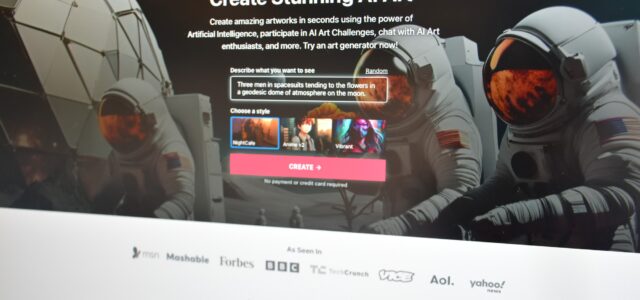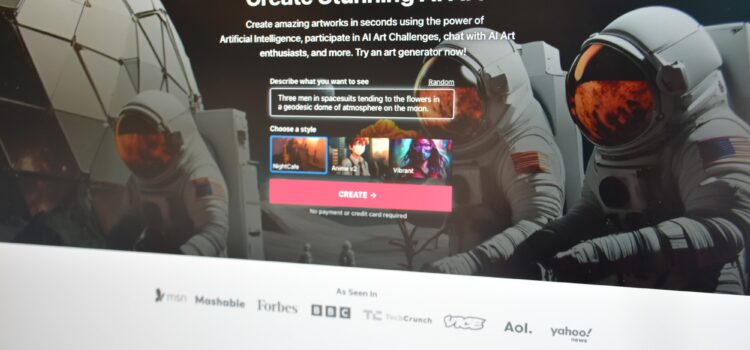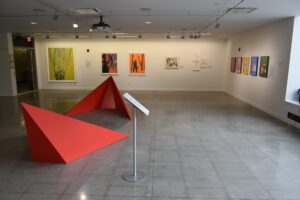

“There will always be a need for an artist”: Humber artists grapple with an AI future
Business & TechCultureNewsVisual arts Mar 27, 2024 Dela Dorkenoo

Following the explosion of interest in ChatGPT, Artificial Intelligence (AI) art generators are now challenging the art world in the same way ChatGPT challenged originality in the writing field.
What is an AI art generator? Similar to ChatGPT, you can enter a text prompt into an art generator to produce a piece of art in just about any style in less than a minute. In some generators, you can use an image to modify through a text prompt.
The technology — and whether it has uses for working artists who understand textures, colours and styles, and art in different eras — is generating some discussion among Humber art students and faculty.
“It always happens in the art world… When acrylic paint first came over oil painting, people said ‘acrylic paint is lame, it doesn’t resemble our art work, it looks like plastic’… Now everyone demands acrylic paint because it is more durable,” said Ebru Kur.
Kur is a gallery assistant and project coordinator at Humber L Space Gallery located on the first floor of the L building. She completed Humber’s visual and digital art program and had a Nuit Blanche installation at the L space in 2023.
She is not against AI art technology, but thinks artists should take an adaptive approach. She also says that the art world always has periods of new innovation that people push back against. Kur understands that AI is a new medium to create art, but views it as more of a tool to enhance works or come up with ideas. She doesn’t agree with artists using AI from start to finish.
At the Humber Art Commons, Marc Colangelo is faculty and program coordinator for the visual and digital arts program at Humber. He teaches a class called ‘Special Topics and Contemporary Practice’ that touches on current topics in the art world.
“I think there are artists who are completely against it and will never touch it. I also think other artists will use it to generate ideas to build off of that. Use it as a starting point and then an artist will make adjustments from that,” said Colangelo.
The technology is still developing but current front runners in the industry are OpenAI’s Dall•E, Microsoft Bing image generator, Adobe Firefly, Midjourney, NightCafe and Jasper Art. The creations aren’t always perfect and sometimes, the AI will generate something different from the prompt. One of the main challenges for art generators is understanding fingers and toes properly. Sometimes — if not most of the times — fingers will look distorted beyond reality and ruin a perfectly good generation.
But Colangelo said the biggest disadvantage is artist credit and royalties. The AI datasets have taken work from real artists to train AI algorithms, but don’t pay them any royalties. He brought up that if you sample an artist’s music, you would have to pay some type of royalties, but AI art has no such system.
For users, Dall•E 1 costs about 0.13 cents USD for each creation. All these generators give the public the option to work on a limited free credit system or paid subscription model. A premium art generation membership can cost anywhere from $5 to $150 per month. But none of the profit is being shared with the artists who built the art generation datasets in the first place.
Powering every art generator is a language module to create images from pre-existing datasets. These datasets can contain millions of images and text descriptions from existing artwork.
The use of existing artwork in the dataset has led to some legal questions. Cases currently being litigated are Andersen v. Stability AI et al., the first class action suit to sue Stable Diffusion and other generative art platforms. Three artists claim their artwork trained their AI datasets based on their work. A judge threw out most of the claims except for one against Stable Diffusion, citing that plaintiffs will need to prove original artwork is “substantially similar” to output images.
Getty filed a similar suit against the same company Stability AI. Getty is an image licensing service citing copyright and trademark infringement. Cases like these will set a legal precedent when it comes to the legal framework of AI generators.
Kur, like a lot of artists, emphasized the importance of the human touch.
“Artists are just not for creating art. They have creative skills for creative solution making. There will always be a need for an artist. Most people can generate their images, but they will never have the same creativity as an artist,” said Kur.








